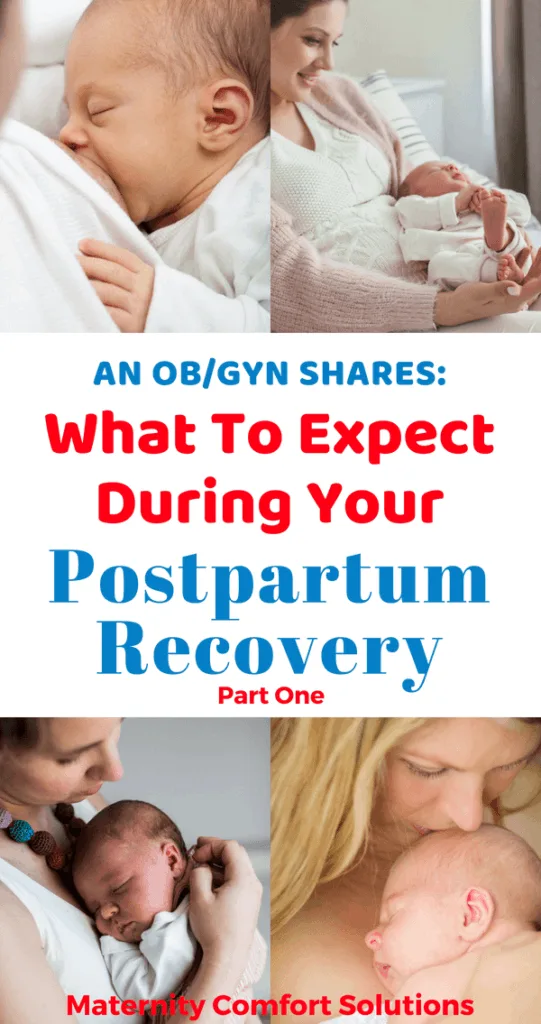Updated August 3, 2022
During your pregnancy, it is essential to set time aside to learn about what to expect during your postpartum recovery. Unfortunately, this is very difficult because pregnant women are faced with so many demands throughout their pregnancy:
- Finding a prenatal care provider.
- Educating yourself about pregnancy and parenting
- Attending prenatal care visit.
- Planning events (gender reveal party, baby shower, etc.)
- Deciding on a labor and delivery birth plan.
- Finally, arranging your postpartum recovery.

This post contains affiliate links. You can read our affiliate disclaimer at the bottom of this post.
Too little time is spent planning one’s postpartum recovery. For some, this will not be a problem if family members are nearby and are willing to help. For others, it can be very difficult. Especially for new moms who have no local family support or a partner who can stay home from work.
The first six weeks after delivery (puerperium) is an exhausting time for new moms. While physically healing from childbirth, new moms are also making the transition from pregnancy to being home and often alone with a newborn.
You can read part 2 in the series here:
What To Expect During Your Postpartum Recovery:
Some problems can arise during your 6-week postpartum course. Bring up any concerns with your prenatal provider right away.
Your routine follow-up visit will be (unless you had a cesarean section) will otherwise be at 6 weeks. Problems suggesting infection, etc.. cannot wait that long.
Normal changes that occur postpartum:
1. The uterus (womb)
- The uterus will go through a process called “involution” over the first 6 weeks. When you are 6 weeks postpartum, your uterus will be back to its pre-pregnancy size.
- Immediately postpartum, your uterus will decrease to the size of a 20-week pregnancy. A uterus that is 20 weeks will be up to the level of your navel.
- You will experience uterine cramps for the first few days after you deliver. These cramps are called “afterbirth pains”. They can be strong, especially when you breastfeed. Breastfeeding releases a hormone called oxytocin which causes the uterus to contract.
2. Lochia (postpartum vaginal discharge)
- The term used to describe the vaginal discharge you will have postpartum is lochia. Lochia consists of blood, mucus, and tissue (decidua) sloughing off from the uterine lining.
- It is assumed that the lochia being referred to is from a normal uncomplicated delivery where there has been no retained placental tissue. After the placenta separates and delivers during the 3rd stage of labor, the placenta is carefully inspected to be sure it is completely accounted for and no tissue has broken off remaining in the uterus. Even with the normal intact delivery of the placenta, the lining of the uterus still has a decidual lining that will have to pass with the postpartum discharge as the uterus involutes during the postpartum period.
3. Vagina and Perineum
- Hormones thin out the vaginal lining (mucosa) during pregnancy. This is very important when it comes to postpartum recovery and is one of the reasons why you will be instructed to avoid vaginal intercourse until 6 weeks postpartum. The thinned vaginal lining needs time to return to its pre-pregnancy condition. This is not a minor issue. On two occasions, I have had to stitch vaginal wall tears caused by intercourse within two weeks postpartum.
- Assuming you had a vaginal delivery, depending on the duration of labor/pushing, the extent of tearing, if you did tear (1st, 2nd, 3rd or 4th degree) your recovery will vary.
- I have had deliveries occur within minutes, where the delivery was completely uneventful. The baby delivered rapidly, there was no pushing, no vaginal tears, and no labial swelling. The mother was up and around soon after the delivery and ready to go home.
- Then, I have had deliveries where the labor was long, there was pushing and labial swelling and in spite of every effort to avoid tears there was a 4h degree tear (a tear extending through the vaginal wall and up the rectum. This is not a common occurrence; however, when you do thousands of deliveries it is going to happen.
- The postpartum recovery course for the two delivery scenarios noted above is going to be drastically different. As will the potential for complications.
4. Breasts
- How your breasts change postpartum will depend on whether you decide to breastfeed or not. If you breastfeed, your breasts will gradually become engorged.
- For women who do not breastfeed the changes in your breasts will be fairly predictable depending on whether or not you decided to breastfeed at all and what measures you take to stop breastfeeding. For women who are not going to breastfeed from day #1, the following routine is best to avoid the letdown of breast milk and most efficiently stop breast milk production.
- Apply ice packs to your breasts
- Wrap a tight binder around your chest or wear a tight bra
- Avoid any nipple stimulation
- Avoid hot showers or hot tubs
The sound of your newborn crying will stimulate the hormonal release and breast milk production. The hormonal axis for breast milk production must be shut down completely before any of the steps listed above can be stopped.
5. Swelling
- Swelling postpartum can be normal or related to problems associated with toxemia or preeclampsia. We are going to discuss only normal swelling.
- The ankles are where most of the swelling settles and this is largely due to the forces of gravity. The reason there can be a great deal of swelling for the first two weeks postpartum is large IV fluids are administered during pregnancy to maintain stable blood pressure,
- During the first few days postpartum, this fluid has to be mobilized out of the tissues and back into the bloodstream so it can be excreted through the kidneys. Diuresis often will take place while you are sleeping. This is because your legs are elevated and this allows the fluid in your tissues to move into your bloodstream and get filtered through the kidneys. Getting up frequently the first number of days postpartum is not unusual.
6. Diastasis Recti (Abdominal wall laxity with separation of the midline rectus muscles)
There are two main reasons why diastasis recti develop during pregnancy:
1. A very large pregnancy or twins/triplets resulting in extreme attenuation of the abdominal wall.
2. An inherent weakness of the supportive structures of the abdominal wall. Explains why some women can have triplets with no diastasis problems and another can have a very small preemie pregnancy and develop diastasis.
7. Hair Loss (Postpartum Alopecia)
- Postpartum hormone changes can cause hair loss. It is the result of a decrease in circulating estrogen. Postpartum hair loss may not be apparent for up t0 3 months and typically the hair that is lost will grow back in 6 to 12 months.
- You may be referred to a dermatologist for postpartum hair loss. Dermatologists deal with this often and will make sure no other medical problems are contributing to your hair loss. (Thyroid function can affect hair loss.)
8. Emotional Struggles
- Having the “baby blues” is experienced by many women. Though hormonal changes may be a contributing factor, feeling “blue” can also result from the overwhelming demands placed on a new mom returning home with a newborn. If you have these feelings call your provider.
- Postpartum depression is discussed often and for good reason. It is common and is simply a continuum or more severe case of the baby blues.
- Baby Blues are considered feelings of sadness that are similar to depression but less severe. Usually, this emotional state will be short, lasting from Day 2 to 2 weeks from delivery.
- Postpartum Depression has the symptoms of depression and when severe can include suicidal ideation and an inability to care for your baby.
Seek help for postpartum depression immediately:
- Whether you feel you just have the blues or postpartum depression, do not hesitate to get help immediately, If you have a history of depression or want to be prepared just in case, arrange any resources for help that will be available to you. This includes family, your medical providers/therapists and community/hospital programs.
- This is not a time to feel you can get through things alone. It is ok that you may need help, this problem is extremely common and you should not avoid help out of embarrassment or the feeling that others will not understand. Postpartum depression is well understood and treatment is effective when accessed.
- It is important to note that if you have a support network in place as a result of a prior history of depression, make sure you have made arrangements to be cared for and evaluated postpartum.
Postpartum Recovery After Cesarean Section
Many of the topics previously discussed pertain to both vaginal births and cesarean sections. However, if you had a c-section, some differences will need to be addressed during your postpartum recovery. The following is a list of some of these differences and what to expect:
- Vaginal bleeding will likely not be as heavy since the uterine cavity is inspected and cleaned at the time of delivery. This leaves less decidual discharge and often less bleeding.
- Your incision will limit how hard you can press on your uterus or any other abdominal manipulation.
- Additionally, your incision will need to be observed for any signs of infection.
- Ambulation and lifting will need to be limited until the abdominal incision has had time to heal.
Postpartum Concerns and When to call the doctor:
- Vaginal bleeding – learn how much is too much before leaving the hospital.
- Fever – when to call.
- If you had a cesarean section call with any signs of infection of the incision: redness, firmness, warmth, drainage, separation or fever.
- If you are breastfeeding, call your provider if you have any signs of infections (mastitis): Fever, tenderness, redness, firmness or persistent lump in the breast after feeding. Mastitis can develop rapidly. Do not delay getting an evaluation if you have concerns about infection or a persistent lump after breastfeeding. (Any lumps that do not go away need to be evaluated to rule out cancer. Breastfeeding can mask cancer so always discuss any concerns with your provider.)
- Abnormal Lochia – If your vaginal discharge develops a bad odor or becomes bright red, call the office. This can be a sign of uterine infection (endometritis) and needs immediate attention.
- Pain, redness, swelling, firmness or warmth in the thigh or legs call the office. Blood clots can develop postpartum.
- If you have any concerns about labial/vaginal healing talk to your health care provider.
Postpartum Complications
If you experience any of the following complications, the most important “take-home message” is to get immediate medical care whether it is day or night. Infections, blood clots, bleeding, etc. are not conditions that can wait until the morning.
Your medical providers know that these are serious problems and are ready to treat them on an urgent basis:
1. Phlebitis or Deep Vein Thrombosis (vein inflammation/blood clots)
2. Heavy Vaginal Bleeding (Retained Tissue, etc.)
3. Infection:
- Mastitis (Breast Infection)
- Uterine Infection
- Urinary Tract Infection
- Incision Infection
4. Postpartum Depression
If you have any concerns about you or your baby call your provider day or night. Medical practices make sure there is always a health care provider covering all their patients.
Read part 2 in the series here:


